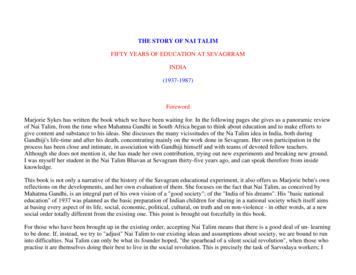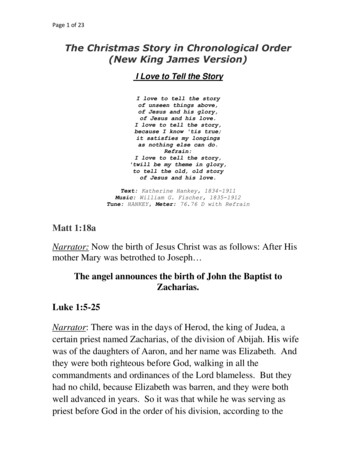
Transcription
THE STORY OF NAI TALIMFIFTY YEARS OF EDUCATION AT SEVAGRRAMINDIA(1937-1987)ForewordMarjorie Sykes has written the book which we have been waiting for. In the following pages she gives us a panoramic reviewof Nai Talim, from the time when Mahatma Gandhi in South Africa began to think about education and to make efforts togive content and substance to his ideas. She discusses the many vicissitudes of the Na Talim idea in India, both duringGandhiji's life-time and after his death, concentrating mainly on the work done in Sevagram. Her own participation in theprocess has been close and intimate, in association with Gandhiji himself and with teams of devoted fellow teachers.Although she does not mention it, she has made her own contribution, trying out new experiments and breaking new ground.I was myself her student in the Nai Talim Bhavan at Sevagram thirty-five years ago, and can speak therefore from insideknowledge.This book is not only a narrative of the history of the Savagram educational experiment, it also offers us Marjorie behn's ownreflections on the developments, and her own evaluation of them. She focuses on the fact that Nai Talim, as conceived byMahatma Gandhi, is an integral part of his own vision of a "good society"; of the "India of his dreams''. His "basic nationaleducation" of 1937 was planned as the basic preparation of Indian children for sharing in a national society which itself aimsat basing every aspect of its life, social, economic, political, cultural, on truth and on non-violence - in other words, at a newsocial order totally different from the existing one. This point is brought out forcefully in this book.For those who have been brought up in the existing order, accepting Nai Talim means that there is a good deal of un- learningto be done. If, instead, we try to "adjust" Nai Talim to our existing ideas and assumptions about society, we are bound to runinto difficulties. Nai Talim can only be what its founder hoped, "the spearhead of a silent social revolution", when those whopractise it are themselves doing their best to live in the social revolution. This is precisely the task of Sarvodaya workers; I
have no doubt this book will help them to see Nai Talim in its true perspective and appreciate its importance for the society ofthe future.As one of Marjorie behn's students I feel personally honoured to be invited to write a foreword for a book which I believe weshall all find useful.Sevagram, Wardha3-11-1987.Kanakmal GandhiAuthor's noteThis booklet should have been written and printed in time for the special Nai Talim conference which marked the GoldenJubilee of the Basic Education movement in October 1987. Because of heavy pressures of other work, however, the scriptwas not ready until the middle of October; various delays and difficulties of other kinds have prevented publication until1988. Perhaps this delay is not important; a subject of such perennial interest as education is always timely; indeed, thequestions raised by Mahatma Gandhi's educational experiment at Sevagram may well prove particularly timely in India andelsewhere during the closing years of this century.What the Jubilee has done is to provide the stimulus, to encourage us to look back on the whole history of the last fifty years,to trace the development of Gandhiji's ideas and to set down the record of how they were worked out in practice by some ofhis closest associates. The writer is personally very grateful to have been offered the opportunity to do this; she believes thatthere may be some value in having an accurate but informal narrative of events written by one of those who were involved inthem "from the inside." Personal bias may be there, of course; it probably is. Nevertheless, when dealing with such a human,living enterprise as education, a personal story may come nearer the truth than any coldly impersonal account, howeverconscientiously documented, which lacks the inside knowledge of how things felt at the time.Perhaps a brief additional comment on the "timeliness" of such a study as this may be useful. There are two major ways in
which the Sevagram experiments appear to be relevant to current debates on education both in India and throughout theworld.The first is that the record rises, in various forms, the question of the optimum size of an educational or social unit. This is notjust a matter of on hoc practical convenience; on the contrary its roots go down to fundamental perceptions of human natureand the processes of human growth and development. Is "bigger" always "better"? -- or may "small" be "beautiful"? Is thepursuit of "efficiency" through mechanisation, or specialisation, or "division of labour," to be preferred to whole, all-roundgrowth ? Do we put our faith in gadgetry, or in personal relationships, as the means of human development? To put itbluntly : how do children learn what is really important from a T.V. or a computer? or from personal contact with a wise andloving adult, among the give and take of work and play with other children? Many of our arguments about educationalorganisation, equipment and techniques are based on our differing but often unspoken assumptions about the very nature ofeducation - is it essentially concerned with putting in information, or drawing out human potential? Which path, in practice,do we follow ?A second topic of worldwide interest and worldwide debate is "education for peace." For Gandhiji, Nai Talim was theexpression of the principle of non-violence in the educational sphere. It was the preparation for, and practice of, the peacefulorganisation of a co-operative human community. In many educational circles however there is a tendency to think of "peaceeducation" as another "subject" on the school timetable, concerned with "putting in information'' on relevant aspects of theinternational political and economic structure, such as the role of the UN, dangers of the nuclear arms race, and globaltensions caused by poverty, hunger and injustice. Yes, information of this kind may have its place - but not if it remains, likeso much else, something to be "mugged up" for an examination and then forgotten. It comes alive, as a real part of peaceeducation, only if it is related to an attitude of mind and spirit which is as relevant at the school level, at the village level, as atthe international level - an attitude which says, in effect : "There is no, way to peace; peace is the way". Education for peacemeans Learning to live peace, daily and hourly, wherever one happens to be, learning to tackle and resolve the tensions andconflicts of outlook and interest which are a necessary and valuable part of human experience. To this learning of the way ofpeace the principles and practice of Nai Talim have a great deal to contribute.Seen from this point of view the story told in this book is only the barest outline. It does no more than suggest possibilitieswhich wait to be explored. Humanity might do worse than spend 'he next 50 years exploring and experimenting withGandhiji's creative educational revolution. For, as we commemorate its jubilee. that revolution has scarcely begun.Marjorie SykesMarch 1988
THE STORY OF NAI TALIMIntroduction: A Personal TestimonyThis story of the Sevagram experiment in Nai Talim is being put together by a seemingly unlikely editor-one who is Britishby blood and birth, a member of the nation whose rule over India was challenged from Sevagram itself. A teacher certainly,but one trained in that system of "western" education which Gandhiji himself regarded as partially responsible formaintaining British rule; a teacher who spent her first ten years in India in Madras, working in one of the many privatelymanaged schools, which, being "aided" financially by Government, were bound in important respects to the Governmentsystem. How did it happen that this particular British teacher got involved in the Sevagram experiment almost from thebeginning?In Madras, that August day in 1937 began like any other school working-day, with classes to be taught and office work to bedone. When the mail arrived personal letters were put aside to be read later. T went to my room after lunch, taking them withme. Among them was my copy of Harijan dated the 31st July. I began to turn its pages and a short paragraph caught my eye :Gandhiji's public description of the kind of education he would like to see made available to the children of India. Those fewsentences drove everything else out of my mind. Excitedly I read them again and again. I still remember clearly the wordsthat came into my head "Here is someone talking real sense about education at last !" I looked eagerly for the next Harijanand the next, and followed the controversies which Gandhiji's proposals had aroused. I read also of the plan to call selectededucationists together for a preliminary discussion that October. I had not met Gandhiji then. I was young and shy, and knewnothing of India outside the south. So it never occurred to me, in spite of my enthusiasm, to invite myself into that meeting. Iknow now that I would have been made welcome, but I have no regrets. Things worked out for me in another way.My excitement about Gandhiji's ideas had not arisen in a vacuum. It was the natural result of a great deal that had gonebefore, right back to my own childhood. We children were expected to help in all the daily chores, the cooking and cleaningof a very simple home. My father drew a modest salary as head-master of the village school in a poor coal-mining communityin northern England. It was an "ordinary" school, but he was not an "ordinary" teacher. He knew that children learn bymaking and doing things, and he spent long hours at home in the evening preparing things for them to make and do, while I,his own eldest child, watched and helped. He showed the school children how to make cardboard models that really worked -
railway signals that moved up and down, a water-wheel that turned when one poured fine sand upon it to simulate the water.Real water would not do for a cardboard wheel, but the principle was the same. So maths and science were learned, and alsomanual skill and accuracy. Geography and history, poetry, music, were linked up with the children's own experience. Once anassistant teacher came who had lived in Canada and knew how to make fire by striking a spark in tinder. Father at oncearranged a demonstration and then let all the children try it for themselves.When in 1928 I began teaching in Madras, I, asked my general science by practical activities using everyday materials. fatherto send me a simple guide-book about how to teach general science by practical activities using everyday materials. He sentme some books, which were used to plan many happy lessons in Madras during the following years. (This was forty years ormore before it became "fashionable" in educational circles in India to talk of using local resources for teaching practicalscience.)Later on my students at Sevagram sometimes asked me where I had been "trained" for Nai Talim. "In my own home," Iwould answer, "by my father and my mother!"As a schoolgirl I knew nothing of Gandhiji; in 1920-21 we were unaware of the great non-cooperation movement in India.But we were very much aware of the Irish freedom struggle, and our sympathies were all with it. Interest in the struggles of"colonial" peoples to assert their own identity persisted during my university years at Cambridge, where we heard from ourIndian fellow students about the national movement and its leaders. We also listened to appeals from many lands for helpwith education. Their young leaders wanted to establish schools which would preserve the values of their own culture andenable them to resist the increasing pressures of the west, and they wanted young British teachers to help them, as equals. Iwas attracted, and soon after completing my training as a teacher I was put in touch with a school in Madras which neededhelp. I reached Madras in the autumn of 1928.The Bentinck Girls High School had grown and developed from a tiny school begun in the time of Lord William Bentinck hence its name. In 1937 when Gandhiji wrote his historic paragraph in Harijan it had reached its centenary; in 1987 when NaiTalim celebrated its Golden Jubilee. the school celebrated 150 veers of work. In curriculum and examinations it was part of'the system", as I have said, but there was still considerable freedom in other ways. Two of my senior colleagues had spenttime earlier in 1928 at Sabarmati and Santiniketan respectively, and had returned full of enthusiasm for what they had learnedfrom Gandhiji and from Gurudev Rabindranath Tagore. One result was that the Bentinck children had learned to singJanaganamana, and were singing it joyfully, long before it became our national anthem. They knew several verses and likedespecially the one which celebrates the comradeship between India's great religious traditions.
Tagore's example strengthened and confirmed our own conviction that the children's mother-tongue should have a centralplace in their education. We were a two-language school with Tamil and Telugu-speaking streams; we saw to it that bothLanguages had their proper place of honour. Sometimes we invited distinguished women, who were taking a leading part in"national" activities in Madras, to tell the children about their work. Many of them had been educated in ‘English- medium"schools and found it easier to speak English than their own mother tongue. We had to persuade them to talk Tamil instead."We want all the children to understand," we would say. "They won't all understand your English. Please talk Tamil." Andthey did.We learned later that Gandhiji also insisted on the use of the mother-tongue, but in those days we thought chiefly of hisshining honesty and simplicity. We were a poor school, most of the children came from humble families, the climate ofMadras was always warm. So furniture was minimal and sandals were rarely used; teachers and children alike ran aboutbarefoot and slept on grass mats on the floor; one small tin box held all of a girl's clothing and personal miscellany. Thesimplicity of Sevagram when I first saw it did not seem strange it embodied, with a special grace and beauty of its own, thesimplicity of the village 'homes of the south and of the children whose way of life they had shaped.I had not been in Madras many weeks when to my great good fortune I met Rajaji. He described Gandhiji's constructiveprogramme and all the nation-building activities which had been inspired by it. He himself was deeply involved in theseactivities, especially in his ashram at Tiruchengode. We teachers began to think what more we might do towards nationbuilding on our own small scale in school, by helping girls to grow into worthy citizens of the free India of the future. AtBentinck, there were a number of things in our favour. First of all we were a "small" school (by present standards), that is, wehad fewer than 350 children all told, from the kindergarten to the school final classes. We thought and still think that this wasthe right size; teachers and children knew one another and cared for one another; we were not too big to be able to feel andact like a big family. Secondly, the school which was under Christian management admitted on equal terms girls of anyreligious background, and of any caste high or low, and treated them all alike. Resident children ate the same food from thesame kitchen, which they helped to run. Local children often brought their midday food and sat down to eat it in little circlesunder our many shady trees. Like children everywhere they sometimes failed to clean up. One midday, looking out from thestaff room, we saw a senior Brahmin girl humbly and quietly clearing away used (and therefore "polluted") leaf-plates leftlying about by her careless juniors, some of them children of the "lowest" castes. She at least, we thought, had caught thespirit of Gandhiji's constructive programme.The children themselves were expected to keep their classrooms and compound clean; we had no servants to do it. Some ofthe classrooms were simple thatched sheds, very pleasant to work in. Their lucky inhabitants happily planted flower- gardensaround them and cared for them. All this meant a lot of cooperative team work; we deliberately extended this cooperative
spirit to the sports and the academic programme. In physical education our aim was not to train a few "star" performers, but tohelp every child to achieve the best that she was capable of, which meant that the gifted children helped the others. It was thesame in the classroom. We gave no academic prizes to the "best" performers; instead we encouraged children to) help oneanother, and watched for and praised the improvement which even the "slow" children showed, with hard work and friendlyassistance. Oh yes, people told us that "children won't work" without the artificial inducement of a prize. It is no and if itsometimes appears true it is because the "work" we expect from the children has no intrinsic interest or meaning for them.Some parents also protested, as one would expect, that they sent their girls to school "to study," not to sweep floors or watergardens; other parents however, including some of the national leaders of the city, deliberately chose to send their girls to usbecause of what we were trying to do within the limits of an "aided" school.But there were limits to what we could do, and from about 1935 I had begun to feel more and more uneasy about them, Onewas the fact that troubled Gandhiji, that education was partially financed by income from licensed drink-shops. Another wasmy growing awareness of how irrelevant much of "the system" was to India's real needs. There was something badly wrong, Ithought, when a girl who wanted to be a nurse, and who was exceptionally well-qualified in personality and skills for justsuch a career, was refused admission to the training course because she could not "pass" in irrelevant subjects like formalEnglish grammar. Another source of uneasiness arose in the context of the 1935 provision for "communal" electorates. Issuesof "conversion" became politically explosive because of their potential effect on communal voting strength. As I have said,the school was a Christian foundation. In previous years I had greatly enjoyed taking Bible classes with girls of allcommunities. We studied the great biblical teaching of public justice and "righteousness" in relation to the message ofGandhiji and to social justice in India. But after 1935 every "communal" institution, no matter how open and honest, might beaccused of secret "proselytising"; the former easy, frank intercourse was shadowed by suspicion. I was dissatisfied with thesegovernmental and other constraints, I longed to be able to work in an independent setting, especially after that August daywhen I first read of Gandhiji's dreams and hopes.In 1938 the way forward opened. Through friends who knew of my position, I received a warm invitation from RabindranathTagore to join the staff of his international educational centre at Santiniketan. I eagerly accepted, and in December 1938 Itravelled to Santiniketan to arrange for my future work. But I did not go by the direct coastal route. Instead I went first toWardha, to see for myself what was going on there and in Segaon, in the new village school and the training centre forteachers. For the first time I met Gandhiji, and was able to talk with him direct about his school and its ideals. I was captured,more fully than ever. What 1 found that December is a part of the story which follows.
IIThe Sowing of the SeedWhen Gandhiji wrote his articles in Harijan in 1937 ire had been thinking about education for at least forty years. By 1896 hehad spent three years in South Africa, but his wife and two little children had remained in India. When it became clear that hiswork was likely to take many more years, he went to India to fetch his family. He returned to Durban at the beginning of1897 with three children, his own sons aged nine and five, and his sister's son who was ten. At once, the question of theireducation arose.Right from the beginning, Gandhiji was clear about three things : the children should live at home, they should not beseparated from their parents and. sent to a residential school; they should learn in their own mother-tongue; they should nothave any privileges which other Indian children could not share.They should live at home because "the education that children naturally imbibe in a well-ordered household is impossible toobtain in hostels." *The intimate relationships of the home were, Gandhiji believed, the foundation of all social and moraleducation, and that was what he regarded as of central importance. "I had always given the first place to the culture of theheart and the building of character," he wrote. Later, when he looked back on those years, he felt that his children had beenable to learn the meaning of "simplicity and a spirit of service" by growing up in a home where these things were beingexplored and practised.Gandhiji was equally emphatic about the use of the mother- tongue, "It has always been my conviction," he declared, "thatIndian parents who train their children to think and talk in English from their infancy betray their children and their country.They deprive them of the spiritual and social heritage of the nation, and render them to that extent unfit for the service of thecountry." But in South Africa English was the recognised medium of communication, and in the schools Indian languageswere taught badly if at all. Gandhiji himself insisted on using Gujarati always when talking with the children, and did his bestto make time to give them a general education through this medium. Whenever possible they would walk with him fromhome to his office, and talk about all kinds of subjects on the way. But his legal practice and public service left him very littleleisure, and both he and they felt the inadequacy of the literary side of their education. Perhaps it was this experience of thepractical difficulties in the way of a complete home education which led him to insist later on the need for organised schools.This did not mean however that any school would do, at any price. In Durban, because of the general respect which Gandhijihad won in the white community, he might have sent his own boys to one of the elite schools which Indian children were
normally not allowed to attend. This he refused to do as a matter of self-respect. They might have had a good literaryeducation - in English, of course - but at the price of being party to an unfair discrimination against their own people. "I gavethem," wrote Gandhiji, "an object-lesson in liberty and self-respect at the cost of the literary training. Where a choice has tobe made between liberty and learning.the former has to be preferred."So thing's went on till 1904. By then Gandhiji's main work was in Johannesburg, but his close links with Durban remained,and he encouraged friends there to start the Indian Opinion, which quickly became his mouthpiece. But the paper ran intograve financial difficulties and he was urged to visit Durban in person. His close friend Henry Polak saw him off fromJohannesburg station and gave him a book to read on the twenty-four hour journey. The book was Ruskin's Unto this Last; itis well known that the profound impression it made on Gandhiji led to the immediate establishment of the Phoenix Ashramon a hundred acres of land about fourteen miles outside Durban, and to the removal of the Indian Opinion press to this newsite. There Gandhiji planned to put into practice the revolutionary idea that had cone to him as he read Unto this Last, that alife of manual labour, of the artisan and the tiller of the soil, is the life worth living. He invited everyone connected with thepress, and other friends in Durban, to come and join in the adventure, to take up three acres of land for each family andbecome farmers in earnest.Naturally only a few responded, although all the press workers agreed to live at Phoenix and work from there. But some didrespond fully, including Chhaganlal and Maganlal Gandhi. The latter gave up his own business in Durban mastered the workof the press, and soon showed his genius for craftsmanship. Henry Polak, hearing what had happened, was delighted, resignedhis own job with a Johannesburg newspaper, and came and joined also. He could not stay long, but he made a finecontribution. With six or seven families, and some growing children, Phoenix became a little village. Sooner or later, it wouldhave to have a village school. Gandhiji planned to give up his own practice and retire there to work on his own three acresand make Phoenix the centre of his service.Outside pressures however were too great, and during the following years they led to the next great "experiment with truth,"the Transvaal satyagraha campaign. In 1909 Gandhiji visited England; on board ship on the way back to South Africa he setdown all his challenges to conventional wisdom in his book Hind Swaraj. It contains, in the form of a quotation from Huxley,his ideal of an educated man :His body is the servant of his will and does its work with ease and pleasure.his mind is stored with knowledge of thefundamental truths of nature; his passions are under the control of a vigorous will and a tender conscience; he has learned tohate all vileness and to respect others as himself. Such a man and no other has had a liberal education.
After Gandhiji returned to Johannesburg he began to feel keenly the need for a place where the dependents of the satyagrahismight live while their bread-winner was in jail, and where the satyagrahis themselves might find a welcome when they werereleased. Previously they had been given monthly allowances "according to need," but Gandhiji felt that this practice offeredtoo much temptation to fraud, and too much risk that injustice might be done to the really deserving. What was needed was: asimple cooperative commonwealth within easy reach of Johannesburg; Phoenix was much too far away.The need was met by another good friend, a wealthy and successful German architect named Hermann Kallenbach. 'On 30thMay 1910 he wrote and offered Gandhiji a good farm, well stocked with fruit trees, about twenty miles away from the city.The matter was settled that very day, and Kallenbach named the new venture Tolstoy Farm. Five days later Kallenbachhimself with Gandhiji and two of his sons, moved to the farm and began to make arrangements for the colonists. Soon therewere sixty or seventy people, men, women, and twenty or thirty children of all ages. They were a mixed crowd; among themwere speakers of four Indian languages, Gujarati, Tamil, Telugu, Hindi, and adherents of four religious groups, Hindu,Muslim. Parsee, Christian. They came from many diverse social environments. They needed a school.Gandhiji dreamed of finding out by experience and experiment "a true system of education" which would put into practice theideal he had put forward in Hind Swaraj. He was already sure that the family was the starting-point, and Tolstoy Farm wasbeing run like a big joint family. There was a common kitchen, which was possible because those who were habitual meateaters voluntarily gave up meat during their time there. The women took charge, and the children regularly helped them byturns, while Gandhiji himself came frequently to assist. The whole community, adults and children alike, were set to work onthe farm, in the vegetable gardens and in the workshop. The children much enjoyed working with Kallenbach; he made themwork hard, but he was also full of jokes and friendliness. Everyone shared in the sanitation work, and there was carpentry,and sandal-making, also led by Kallenbach. He had got himself specialising trained and he taught Gandhiji sandal-making inhis turn: With all this bodily exercise and simple healthy food the children grew well, and there was very little sickness.Naturally there were some high-spirited pranks, and sometimes the work suffered, but not for long. There was a sound rulethat children should not be asked to do things that their teachers did not do; a teacher would work with them at every kind oflabour, so things went fairly well, even though it was a completely new experience for all the children. Their Johannesburgschools had taught nothing but the "three R's."At Tolstoy Farm there were regular school classes, two or three periods each day. These had to take place in the afternoon,and both teachers and children were often sleepy after doing a morning's work in the open air. There were other difficulties;Gandhiji and Kallenbach, who between them did most of the teaching, had to spend at least two days each week inJohannesburg, and there were very few others who could help. All the same, some good work was done, and Gandhiji himselffelt that with all its short-comings "the most substantial result of the (satyagraha) struggle is the school." He himself
undertook to teach the illiterate Tamil children to read and write their own language, which he had studied in jail. Of spokenTamil, they knew far more than he did, and they used to act as his interpreters when Tamil-speaking visitors came to see him.For Gandhiji never attempted to disguise from his pupils his own ignorance. How often, in later years, the writer had to pointout to the teachers who came to Sevagram to be re-trained for Nai Talim, that it does nothing but good for the teacher to sayfrankly, as occasion arises, "I don't know that; shall we try to find out together?" Such honesty will win their pupils' love andrespect, just as Gandhiji did.Besides language, there were classes in arithmetic and hand- writing. Gandhiji always lamented his own ill-formed, hand, andconsidered that education was no
have no doubt this book will help them to see Nai Talim in its true perspective and appreciate its importance for the society of the future. As one of Marjorie behn's students I feel personally honoured to be invited to write a foreword for a book which I believe we shall all find useful. Sevagram, Wardha 3-11-1987. Kanakmal Gandhi Author's note










